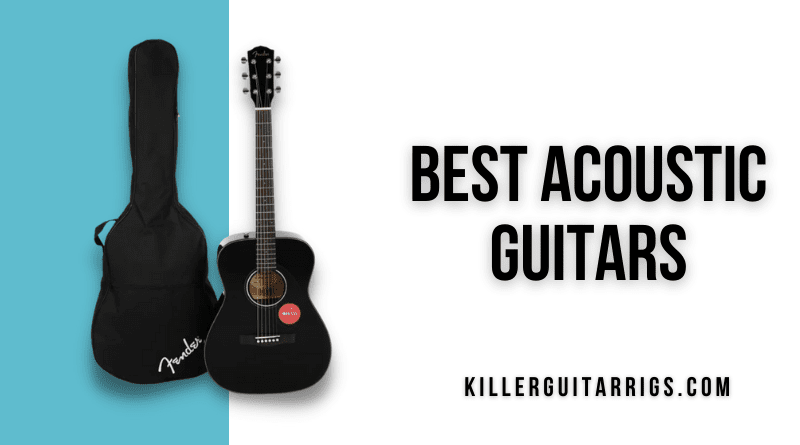When in the market for an acoustic guitar, it can be tough to know where to start, regardless of whether you’re a seasoned player or a day one beginner looking for your first acoustic guitar. There are so many different brands, styles, and models of acoustic guitars available that narrowing down the right one for your playing style can be challenging.
In this KillerGuitarRigs Guide, we’ll do the legwork for you by running down our most recommended acoustic guitars on the market today. We’ll be covering quality options at all ends of the price scale, so no matter your budget, you’ll find the perfect guitar in this list.
When testing these guitars, we paid attention to tone, construction quality, features, and comfort in order to get a full picture of their overall performance. For models with pickups, the same amplifier was used throughout. In this case, a Boss Katana 50 MkII.
Read more about our review process.
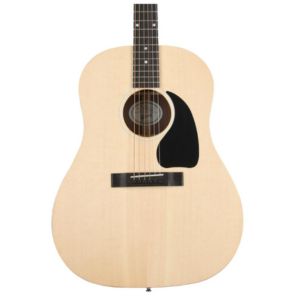
Gibson G-45
Features: All solid wood construction, Player port, Nitrocellulose top coat
Benefits: Beautiful tones, Awesome responsiveness, Excellent neck speed
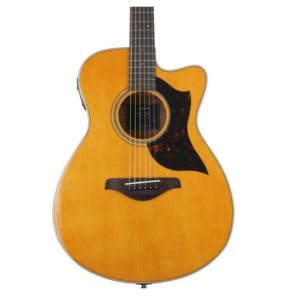
Yamaha AC1M
Features: Big midrange punch, Fantastic playability, Organic amplified tones
Benefits: Solid Sitka spruce top, SRT piezo pickup, Built in tuner
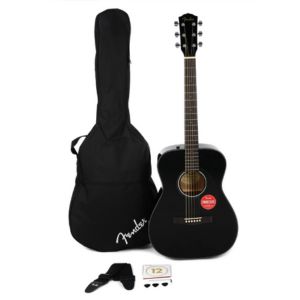
Fender CC-60S
Features: Concert style body, Solid spruce top, Rolled fretboard
Benefits: Extremely comfortable, Bright tones, Great tuning stability
Contents
Our Top 3
Our Top Pick is the Yamaha AC1M. It offers high-end features normally seen on premium models, while remaining accessibly priced. Yamaha used quality woods throughout and the overall build quality is unparalleled at this price point.
The Fender CC60 is our Budget Choice. It’s a classic dreadnought from one of the biggest brands in music. This is a dynamic and versatile choice, with a great palette of tones, at an almost unbelievable price, making it one of today’s best deals on the market.
Our Editor’s Choice is the Gibson G-45. This is one of the best all-rounders Gibson has ever produced. It’s unmistakably Gibson, loaded with cutting-edge features that enhance performance while maintaining a classic look. Like all Gibson guitars, it’s hand-crafted in the USA and made using quality tone woods throughout.
Individual Reviews

Yamaha AC1M
Understated good looks, superb build quality, and wonderful tones.
This guitar is a true sleeper. At this price point you might be tempted to look at an entry level Taylor or Martin, but with this Yamaha you’re getting so much more for your money. It uses solid woods throughout, quality fixtures and fittings, and Yamaha has some of the finest QA of any manufacturer.
Yamaha is well regarded as one of the world’s finest instrument makers, and that accolade definitely includes their guitars. We found the Yamaha AC1M to be a wonderful player, with beautiful tones and incredible attention to detail.
After pulling the guitar out of its box (sadly, there was no gig bag), we were greeted by a good-looking electro-acoustic concert-style guitar brimming with vintage-style charm. It had a solid Sitka spruce top and solid mahogany back and sides.
The neck was also mahogany, and we found that it was comfortable and fast-playing. The profile wasn’t listed in the specs, but by eye (and feel), it’s approximately a slim C shape. The fretboard was genuine rosewood, which for solid wood is a rarity at this price point and a very welcome touch.
After spending some time playing it, we found that it was tightly focused in the mid-range and had a punchy top end. It performed extremely well with softer playing and fingerstyle, too, with glassy overtones and subtle nuances.
Of course, compared to a dreadnought, especially the Gibson G-45, it did lose out on some presence, likely due to the reduced body depth. To make up for the lost volume, it did feature an SRT piezo pickup and a System 6 preamp, which did well to capture the bright character of the guitar.
Verdict: The Yamaha AC1M is priced like a midrange model and still manages to hold its own against guitars costing twice as much, making it one of today’s best deals. It’s built to Yamaha’s strict standards, which are amongst the highest of any manufacturer. The slightly smaller concert size gives it an edge comfort-wise against full-body guitars like jumbos and dreadnoughts without having to sacrifice much tonally. We chose this as our Top Pick.
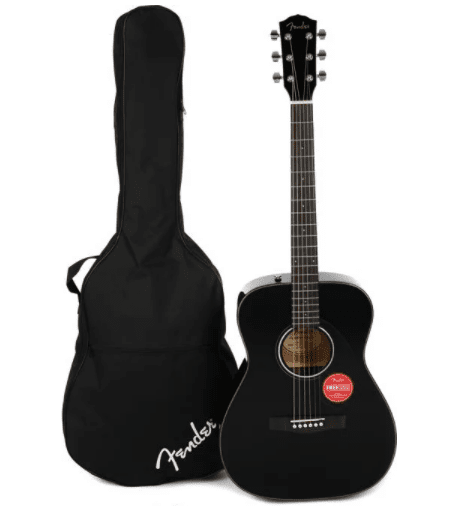
Fender CC-60S
Unbelievable value for money in this handsome, well equipped acoustic.
If you’re looking for pure value for money, this Fender is one of the best options out there. You’re getting a genuine Fender that sounds great, and because it’s well made, it offers excellent tuning stability, comfort, and playability
The Fender CC-60S (full review here) is, without a doubt, one of the best low-cost acoustic guitars on the market. Fender seems to have perfected the art of packing in huge amounts of features without having to increase the cost, which is a huge feat in itself, making this one of today’s best deals.
This model isn’t just a guitar in a box, but rather a whole kit. Inside the box, we found a nice gig bag, a strap, some picks, and a spare pack of strings. Everything you need to get started.
It follows the same formula as most of the world’s most popular acoustic guitars, with a solid spruce top and mahogany back and sides. The model we tested was finished in a gloss black on all sides, so we couldn’t see the grain, but we did like that it looked a little different.
The neck was made from nato, which is a low-cost (and popular) alternative to mahogany. We found that it had a comfortable, slim profile that really promoted good form from the fretting hand. The frets were finished well, which is the mark of a well-made guitar in the budget category, and it even had rolled edges on the walnut fretboard.
Tonally, it was way more balanced than we expected. It had a surprising bass response considering the concert-body shape, and a strong midrange response. Up at the top, there was a hint of shimmer, but not so much that it sounded shrill, which is a common problem in this price range.
Build quality was another strong area. Tuning stability was rock solid, which was no doubt aided by the use of genuine Fender strings. It was well-intonated, and as we mentioned earlier, the fret edges weren’t sharp and the crowns were well-leveled.
Verdict: The Fender CC-60S is a stellar choice when it comes to low-cost acoustics, making it our budget choice. It sounds great, and we loved the black finish, although it’s available in a natural spruce or all mahogany if you aren’t into the black look. Build quality is far beyond what you’d expect at this price, making it one of today’s best deals for a budget acoustic on the market.
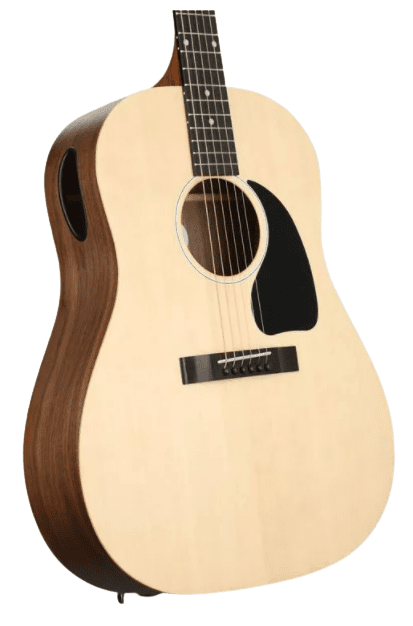
Gibson G-45
Rich tones and that iconic Gibson Acoustic body shape.
With this Gibson acoustic you’re getting one of the most affordable “made in the USA” models on the market today. It’s lightweight, comfortable, and packed with bright tones that are perfect for accompanying a vocalist.
We had a great time testing out the new Gibson G-45 (full review here). This updated model is part of the new Gibson Generation Collection, a group of no-frills guitars that sacrifice embellishments for quality craftsmanship and high-end materials.
After unboxing the G-45, we found that it came in a really nice gig bag. It wasn’t the same hybrid-style case that you get with electric models, but it was still well-padded and comfortable to carry.
The wood grain on the solid Sitka spruce top was very subtle, which is an appealing factor for those players who like their guitars a little plainer. The back and sides were finished in walnut and had a more exciting grain than the top.
Its “advanced response” profile neck was made from Utile, which is a more sustainable mahogany alternative. We found it to be exceptionally comfortable in the hand, causing no fatigue whether we played rhythm or lead.
Tonally, the G-45 gave us some beautiful, bright tones with huge volume and presence, just as you’d expect of a full-size, round-shouldered dreadnought. It had a tight focus around the mids and a sparkling top end. The tones slice through almost any mix with ease and when playing fingerstyle, the articulation and note separation were fantastic.
The new player port was something we’d never come across before, and were pleased to get the chance to try it. In the Generation Collection, Gibson has added a second sound hole in the upper bout on the bass side of the guitar. The objective is to let the player hear the true tone of the guitar directly, and we were quite impressed by how well it worked. It was similar to the effect of playing with a monitor. For that reason, we think this feature would make the G-45 a great studio guitar.
As far as build quality was concerned, this guitar is heirloom quality. While it isn’t the flashiest of acoustic guitars, it’s made from choice cuts of solid wood and is finished in a beautiful satin nitro lacquer. We found that tuning stability was excellent, and intonation was dead on.
Verdict: The Gibson G-45 is subtle, but beyond the plain exterior lies a guitar that delivers big time on stage, in the studio, and at home. It brings sparkling tones and still manages to maintain clarity even when pushed hard. This is a solidly-built guitar that is clearly made to last, despite its light weight, making it our Editor’s Choice.
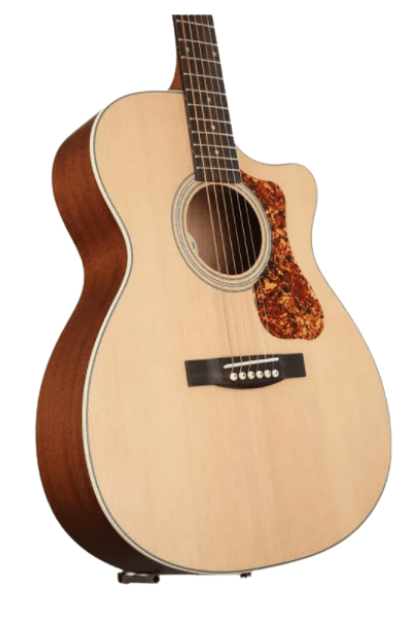
Guild OM-240 CE
An Orchestra body acoustic with great tones and fantastic details.
If you’re looking for a mid size acoustic at a great price from a brand with history, this Guild might be just what you’re looking for. Standing out from the crowd with its arched back, this guitar is comfortable and lightweight, yet it boasts a big voice.
Guild guitars are some of the nicest and most unique acoustic guitars you’ll find anywhere. They use innovative design to push the limits of guitar-building technology without losing sight of their heritage. The Guild OM-240 CE is a great example.
Unfortunately, the OM-240CE did not come with a hard case or a gig bag. More and more manufacturers are starting to include some kind of travel or storage solution as standard, so it was a little disappointing to see that this model didn’t. It was well packaged from the factory, however, so the guitar was received in pristine condition.
The orchestra-shaped body was sleek and was well complemented by the Venetian cutaway. It had a solid Sitka spruce top and mahogany back and sides. Its red faux tortoise-shell pickguard was a nice throwback and gave it a really cool vintage look.
It came with a solid mahogany neck in a vintage C profile. It was narrow but quite deep, which we found comfortable, but those who play a lot of barre chords might find themselves getting fatigued quickly. The fretboard was Pau Ferro, which is a rosewood substitute. We found it to be a little dry feeling, but some fretboard conditioner would quickly fix that.
This guitar was a lot of fun to play, delivering some bright and punchy tones and surprising depth thanks to the arched back, which can provide better projection than flat-backed equivalents. It was far better suited to fingerstyle and lead-style playing than it was rhythm. The cutaway provides easy access to the upper frets, allowing for easier use the entire fretboard.
It was also equipped with a Guild AP-1 piezo pickup, which we found amplified the guitar well without masking its inherent characteristics.
Build quality was good. We found that the fretwork was well done, and even the inside of the cavity was nicely finished, always a sure sign of a well-made acoustic guitar. It was equipped with a bone nut and saddle, both of which helped tremendously with tuning stability, intonation, and sustain.
Verdict: The Guild OM-240CE offers something a bit different from the usual crowd, and the arched back is definitely a conversation-starter. It’s a well-made guitar from one of America’s oldest brands. It sounds good and has a lot to offer without breaking your bank.
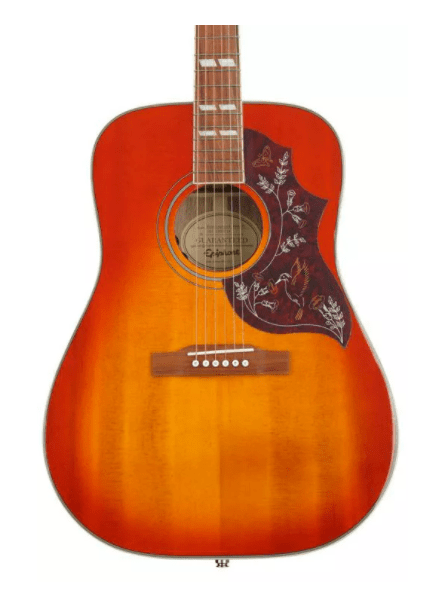
Epiphone Hummingbird Pro
Premium appointments and superb build quality.
If you like unique guitar designs that still sound incredible, this Epiphone is sure to pique your interest. It uses a blend of high quality woods, and is topped off with a gorgeous sunburst finish. It excels with projection and articulation, and has a smooth tone that’s instantly recognizable as a Hummingbird.
This isn’t one of Epiphone’s US-built Frontier models, but regardless, it’s beautifully made and is easily one of the nicest-looking guitars on the market. We had a lot of fun experimenting with the Epiphone Hummingbird Pro, learning in the process that it thoroughly deserves its place on this list.
Like the Guild, this Epiphone does not come with any kind of case or gig bag. Considering this is not a budget-model acoustic guitar by any means, we really expected to see something included. The guitar has a faded-cherry finish that will quickly scratch and dull if it’s not stored in a protective environment.
The top was solid spruce and the back and sides were high-gloss mahogany (a classic pairing with a solid-spruce top). The cherry sunburst finish was beautifully applied and we loved the elegant and distinctive hummingbird pickguard, inspired by the design worn on the Gibson Hummingbirds played by the likes of Keith Richards, Lenny Kravitz, and Chris Cornell.
It had a mahogany neck with a Slimtaper D profile. Players with small hands will enjoy playing this guitar, but if you prefer a large neck, you might want to look at an alternative model. The fretboard was made from Pau Ferro, which we found to be one of the nicer PF boards we’ve experienced. It wasn’t dry, the pores weren’t too open, and it generally felt good under the fingers.
The tones were a little darker than some of the other models we tested, which is likely due to the cavernous body. There was still some shimmery top end, but the tone profile was more mid- and bass-focused.
We found that it wasn’t the best fingerstyle acoustic guitar. Despite the slim neck, the large body presented some challenges when attempting more complex passages. In addition, this is a guitar that wants to be loud all the time, so more delicate playing styles can be difficult to get right.
It was equipped with Fishman electronics, which sounded great, and featured a well-positioned volume/tone control right inside the soundhole.
Verdict: The Epiphone Hummingbird Pro comes from a manufacturer with a long and rich history when it comes to making acoustic guitars. The design is timeless, and the tones are booming. It has incredible volume and projection, so it’s well-suited to blues, country, and worship players. This is a great option for players who like a guitar that sounds as good as it looks and those who have a preference for slim necks.
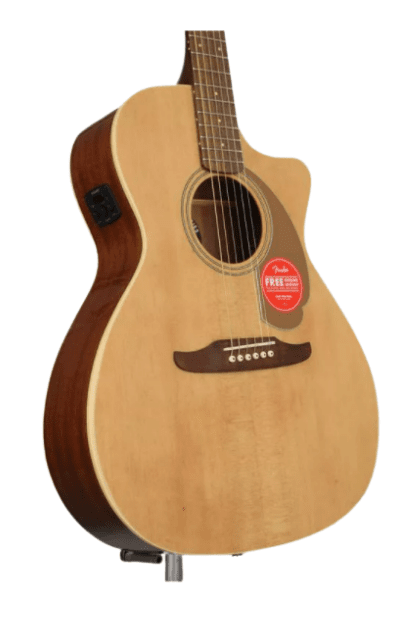
Fender Newporter Player
A newer model that is fast becoming a cult classic.
This is a great option for electric guitar players looking to transition to acoustic without much change in playing feel or aesthetics. It features an incredibly comfortable body, and has electronics designed for a versatile playing experience.
This was the first time we’d gotten hands-on with the new Fender Newporter Player, and after having heard so much about it prior to the review, we’re glad we got the chance. This guitar was a lot of fun and will definitely have a lot of people rethinking how they look at acoustics.
It was well prepped for delivery, with a lot of securing material in the box, but sadly no case or gig bag.
The Newporter we received to test was fantastic to look at. We had the natural finish, which came with a classic combination of a solid spruce top and mahogany back and sides (solid wood choices), finished off with an unusual but nonetheless beautiful caramel pickguard, which gave it a 70s vintage aesthetic.
It was equipped with a Stratocaster style slim taper C neck, also made from mahogany. Those who have previously played Fender’s electric guitars will be familiar with this fast-playing profile, which works really well on the Newporter. Completing the look, it was even equipped with a Strat-style headstock, complete with 6 in line tuners, a really unique touch that we liked a lot.
There were some high-end appointments throughout, including a GraphTech NuBone nut, a genuine walnut fretboard, which both looked and felt fantastic, and even a walnut bridge.
The body itself was quite shallow for an acoustic guitar, which did affect the volume and projection that the guitar delivered somewhat. Tonally, it was nicely balanced overall and had a surprisingly big low end to compliment the prominent highs. Sounds were punchy, and it had no issue cutting through a mix.
If you prefer to play plugged in, like us, you’ll appreciate the Fishman pickup and preamp, which had an easy-to-operate EQ, and even a built-in tuner.
Verdict: The Fender Newporter Player is about as well made as a guitar can be. It’s rock solid and uses quality components throughout. It has a modern look with a slimline body that really begs to be played hard, whether plugged in or played acoustically.
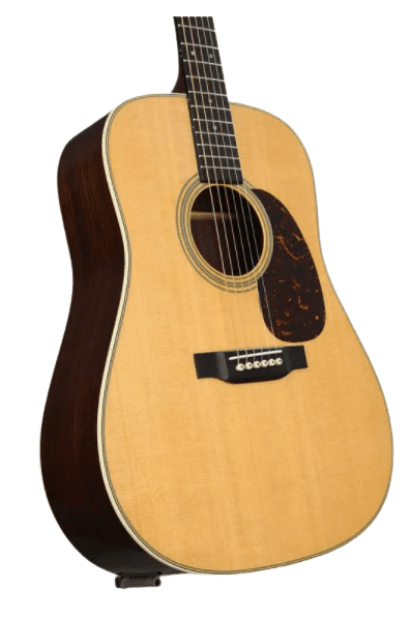
Martin D-28
A storied guitar, crafted by some of the world’s finest luthiers.
Martin’s D-28 is the guitar to have if you’re looking for something special. This model features the best quality woods and is assembled by some of Martin’s most experienced luthiers. The result is an unparalleled playing experience, and overall sonic excellence.
If you take your guitar-playing seriously and you’re looking for a professional quality, high-end acoustic guitar, they don’t get much better than the Martin D-28. This is the guitar that defines the term “industry standard,” thanks to its incredible voicing, huge presence, and flawless build quality.
Full-size Martin guitars all come with a hard case, but high-end guitars like the D-28 come with an upgraded polycarbonate case. It’s plush on the inside and solid on the outside, perfect for keeping your precious cargo safe from harm.
All of the guitars on this test were good-looking, but none quite compared to the D-28. Before even getting to strum a note, we knew it was special from the way it looked alone. It was made with a solid Sitka spruce top that had been gently aged prior to its coating in nitrocellulose lacquer. The back and sides were made from East Indian rosewood, a true luxury material even among top acoustic guitars, and one that genuinely adds character to both the look and sound of the guitar.
It had a sublime neck design, with Martin’s modified low-oval profile with a high-performance taper providing comfort and incredible access to the ebony fretboard from all positions, regardless of whether we were playing barre chords, jazz chords, or single notes.
The tones were everything we expected of a Martin acoustic guitar and more. That’s really what sets them above their only real competitor in this space, Taylor Guitars. The balance between the bright Sitka spruce top and the East Indian rosewood back and sides provided a yin-and-yang sort of harmony. The top gave us shimmer and sparkle, while we got incredible bass and mid response from the warm rosewood.
It had a confident voice and such presence that getting lost in a mix would be near impossible. When we played fingerstyle, we were treated to exceptional nuance and breathtaking note separation.
Of course, tone like that is the result of an accumulation of top-quality components and peerless craftsmanship. The open-gear tuners are a classic example. They look stunning, but also happen to be some of the highest-quality tuners we’ve used on any guitar anywhere. You get a genuine bone nut and saddle and, of course, genuine mother-of-pearl inlay fretboard markers.
Verdict: It’s not a difficult job to sing the praises of high-end acoustic guitars, but it’s even easier in the case of the Martin D-28. It offers unbeatable playability and incredible tone, and as evidenced by the antique Martin acoustic guitars still available today, it will last for 100 years or more if you treat it right.
How to Choose the Right Acoustic for You
When looking to buy an acoustic guitar, there are a few things you need to consider before making your purchase.
Regardless of which specific guitar manufacturers you favor, the two most important factors to consider are body shape, which affects sound, projection, comfort, and wood selection, which has a huge impact on the overall tone of the guitar, whatever type of guitar player you may be.
While many of the tenants of picking a guitar are similar between electric and acoustic, such as picking the right neck profile for your hand and avoiding acoustics if you’re more on the black-metal end of the musical spectrum, we’ve focused our advice on body shape and picking the right tonewood for your playing style.
There are reasons to avoid or to buy just about any shape or wood, but we’ll try to give you enough to get started. You’ll find additional info on related buyer’s guides on the site.
It’s also worth keeping an eye on places like Sweetwater’s deal page to leave yourself open to spotting deals.
Body Shape
There are a variety of different acoustic guitar body shapes available. Some of the most popular shapes include dreadnought, jumbo, and orchestra. Ultimately, your choice will depend on your playing style, and of course, if you’re buying for a child, you’ll want to favor a small body.
The dreadnought is one of the most popular acoustic guitar body shapes. They are famous for their large size and deep body. The huge sound of a dreadnought is a good choice for guitarists who want a lot of power and projection in their sound compared to a smaller-bodied acoustic. Perfect for a small-room live performance.
The jumbo is larger than the dreadnought and also has a deep body profile, which, of course, produces a louder sound. Jumbo bodies are popular in the country world and have incredibly bright top ends to complement their massive sound.
Orchestra acoustic guitar bodies are smaller in size than dreadnoughts and jumbos. Orchestra body guitars are amongst the most comfortable, which makes them ideal for guitarists who play intricate music styles.
Concert-style acoustic guitars are slightly smaller cousins of the orchestra style. Concert acoustic guitars have a bright, punchy sound compared to bigger-bodied guitars and are often used in jazz, country, and blues music.
Tone Wood
Four of the most common types of tonewoods used in acoustic guitars are solid spruce (typically Sitka spruce), walnut, mahogany, and rosewood. Your choice of solid wood, along with body style, will have a huge effect on the sound of your guitar, as they will differently interpret string vibrations depending on their hardness.
Spruce is a strong and flexible material that produces a bright tone. Spruce trees are also fast-growing, which makes it a sustainable and affordable choice, and one of the most popular acoustic guitar tops.
Walnut is a great tonewood for guitars because of its balanced sound, especially in a small-bodied guitar. It has a warm low end and a bright high end, making it a versatile choice.
Mahogany is often used in acoustic guitar construction. It has a warm tone with a mellow midrange and good sustain. In recent years, the Sapele neck has seen some popularity as a replacement for mahogany.
Rosewood is an aesthetically beautiful wood that also happens to have a full, rich sound. As one of the hardest woods, it makes a highly durable choice.
There are some acoustics produced with a maple neck, but (depending on the solid top) it tends to be too bright for the more mellow acoustic tone.
One other “wood” to be aware of is high-pressure laminate, which is essentially layers of paper-thin wood laminated, used for parts or even all of the back, sides, or top. While this can be more consistent and is certainly cheaper, high-pressure laminate (or HPL) won’t have the same tone as solid woods.
Additional Considerations
Something else to consider with an acoustic is the scale length. Typically, an acoustic guitar will have a scale length of either 24.75 inches or it will be somewhere between 25.4 and 25.5 inches.
Generally speaking, if you’re looking for a tighter tone, go for the shorter scale length. If you want to emphasize bass, head to the longer scale length.
Scale length also has a huge effect on string tension, so that will be a consideration for intonation as well as playing feel. You’ll need to play around with string gauge and scale length to find your ideal sound, especially if you’re shooting for a balanced tone. If you’re new, ask a friend or guitar teacher to help!
Final Thoughts
Shopping for an acoustic guitar is a deeply personal experience. There are so many individual factors that influence what we like or dislike about a particular model, so we hope you’ve enjoyed reading about this diverse group of guitars. Remember that price doesn’t dictate quality, so settle on your budget and then choose accordinly (if it helps, we have separate roundups of high-end acoustics, budget acoustics and acoustics under $2000)
Another thing to remember is that this list of acoustic guitars is, to an extent, influenced by the guitars that are available on the market. There are some incredible acoustic guitars that we excluded, as they are not readily available, and we don’t want to sing the praises of an acoustic guitar that you can’t actually purchase! As always, keep an eye out for today’s best deals in the acoustic guitar world, as the right guitar is always the one that hits both price and performance.
To recap: Our Top Pick acoustic guitar, the Yamaha AC1M is a solid choice for players looking for a high-quality guitar that works in any situation. If you’re trying to keep costs down, we’d recommend the Fender CC-60S as our Budget Choice. If you’re simply looking for the very best at any price, you won’t be let down by our Editor’s Choice, the Gibson G-45.

